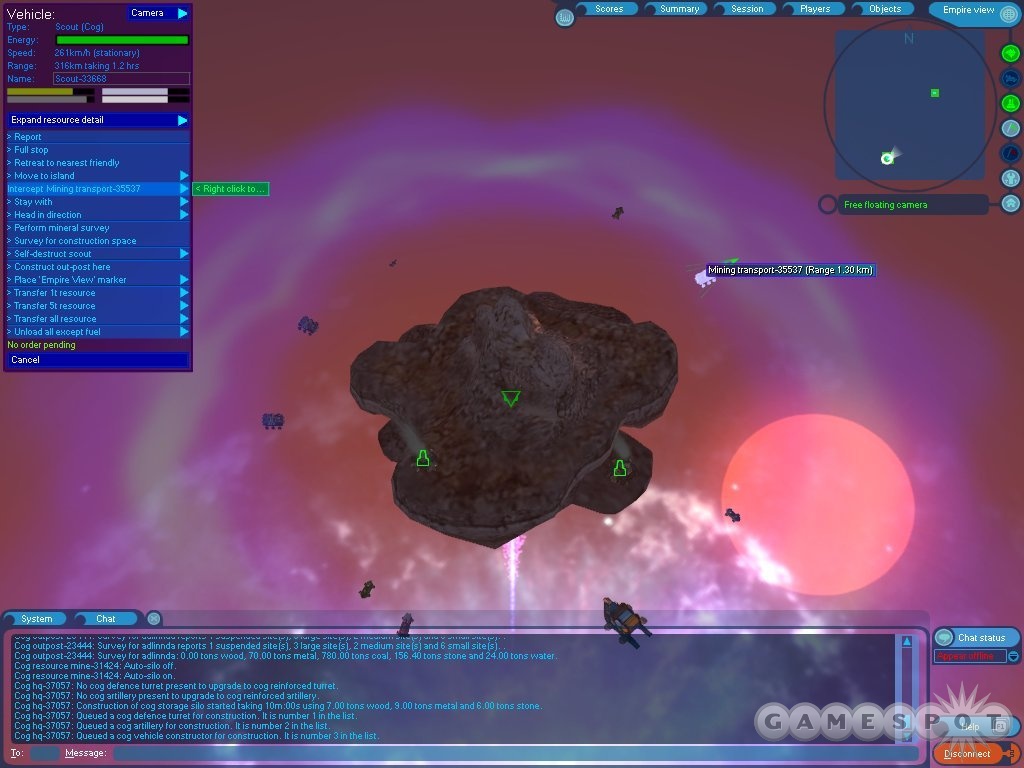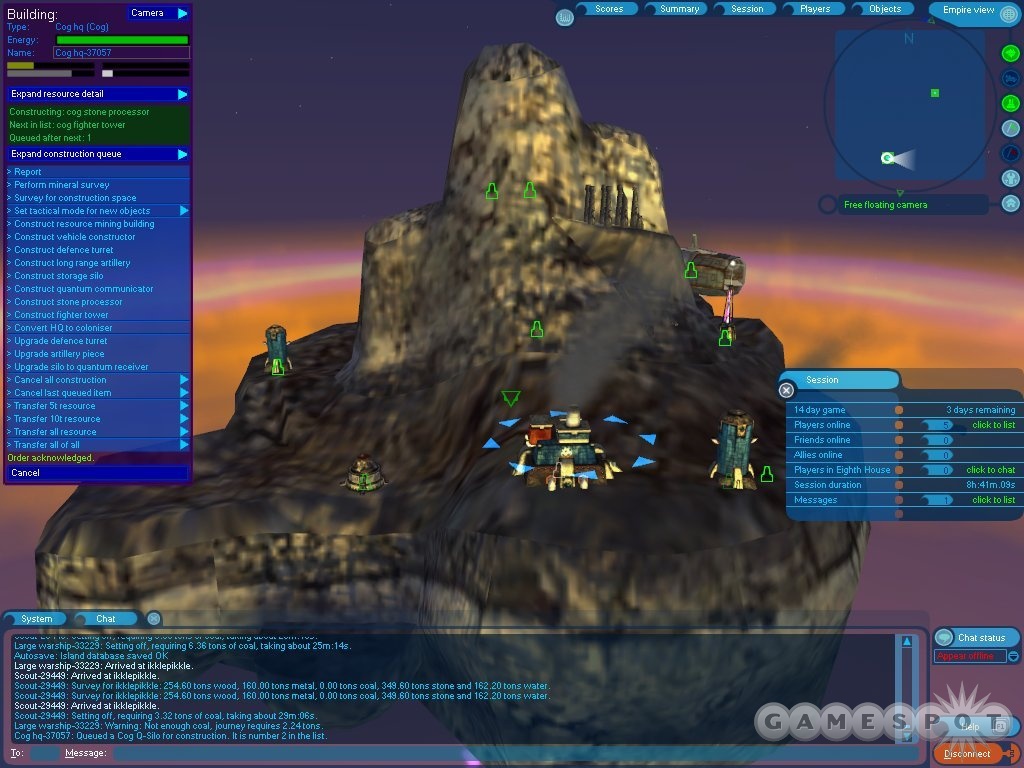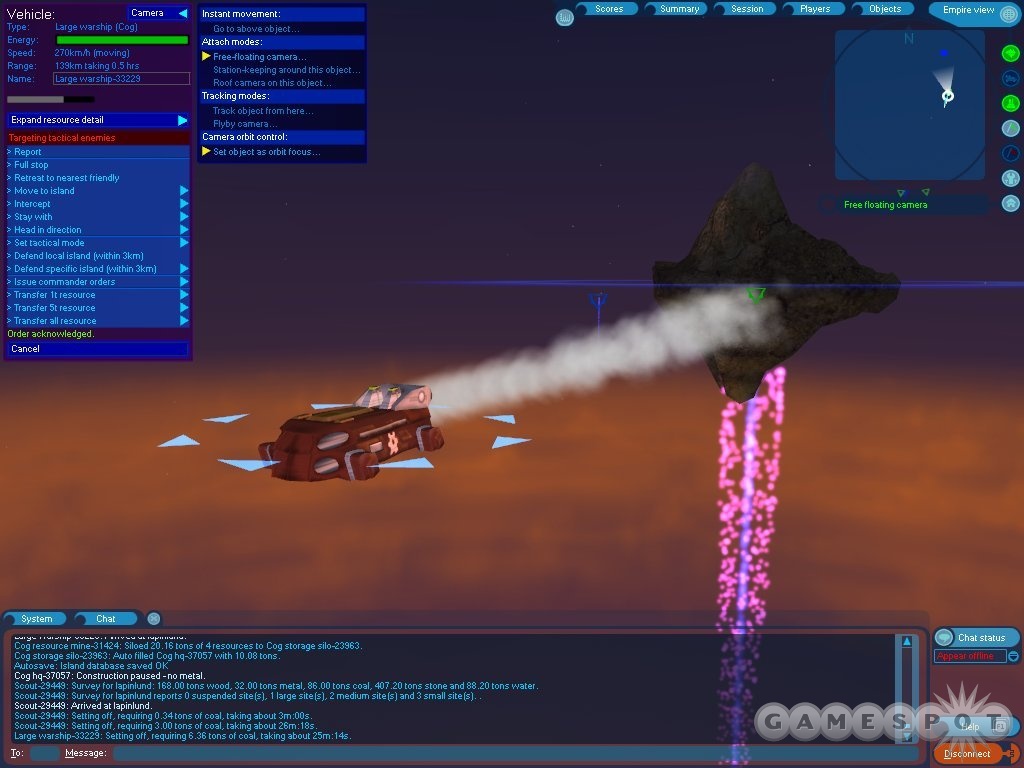Offbeat and awfully familiar, Time of Defiance is one of those odd games that seems simultaneously like a stranger and an old friend. The massively multiplayer real-time strategy game from UK developer Nicely Crafted Entertainment blends antique base-building and combat conventions with innovations, like a persistent world that never sleeps and buildings that are constructed in real time. This gives a new look to an old genre and provides for some very challenging moments, both in the way you play the game and in the way you approach playing it.

However, Time of Defiance certainly won't be everyone's cup of tea. For starters, the gameworld of Nespanona isn't the usual planet or nation that can be conquered one region at a time. Instead, you compete for the remains of the northern province of Nespanona after a cataclysm has reduced the country to islands that are held in place above the former planetary core by energy beams. Each of these fragments represents a standard RTS territory that contains various amounts of resources, like coal, wood, metal, stone, water, and crystal moss. So aside from the rather eerie, almost Cloud City-esque appearance of the environment, everything here is what you would expect in such a game.
And like any traditional RTS, the goal here is conquest. As a result, you start with one island and a small fleet of ships. You must then spread out to other islands by gathering resources and building more bases and ships. The process of doing so is entirely ordinary. You construct headquarters, mines, weapons platforms, and other facilities that are all pretty much centered on resource production. You also explore with scout ships and send out colonization vessels and warships to add new lands to your growing empire.
There isn't much complexity in the game's core RTS elements. Buildings are limited to essential types, and resource-gathering is streamlined by the use of single types of mines and storage silos. Almost everything can be automated, so there is no micromanagement. All you have to do is build the necessary structures and tweak a few settings. Then your resource system runs like clockwork, right down to the automatic fueling of vessels at bases. Combat is equally straightforward in that you rarely need to do more than band-select a fleet and hurl it at an enemy system. There is no tech tree, since all advanced Shadoo vessels are purchased from the Eighth House (the computer-controlled overlord of Nespanona) with water and crystal moss. About the only real concern is transporting resources to different islands, because the amounts found on each rock vary tremendously. Even this can be set on autopilot, though, by building a quantum net system that beams goods from one island to another.
That's it for the derivative stuff, though. Time of Defiance pulls away from the standard RTS conventions by offering a massive world that operates in real time. Constructing even a basic building like a mine takes around 10 minutes. Islands are thousands of kilometers apart, so ships routinely have to travel for 20 to 45 minutes to reach their various destinations. Fully scouting even one sector requires well more than an hour of your time. And to top everything off, the gameworld keeps going even when you log off. Consequently, whether you're online or not, your empire is fair game to any predator.
All of the above adds a level of commitment not seen in the usual massively multiplayer game, where you're taken out of harm's way as soon as you log off. It enhances the tension of every move. You have to think long and hard about building a salvage vessel, launching a fleet against an enemy, or even just sending a scout ship out for a look around the neighborhood, because carrying out every single order takes up a lot of time. In some ways, the tension is similar to that of playing a shooter without saving in that you know that any mistake you make will be very costly.

Having the gameworld persist around the clock is a more dubious design decision. Still, it's hard to see what else Nicely Crafted Entertainment could have done with a massively multiplayer RTS, because there wouldn't be much to do if empires were locked in place every time a user went offline. Also, the absence of a safety net really ups the importance of strategic defenses. If you hope to give your empire even the slightest chance of repelling enemies while you're offline, you have to build gun turrets and artillery pieces, and you have to anticipate invasions by placing fleets in just the right positions. This absence of a safety net also emphasizes the importance of diplomacy, since making deals with other emperors may be the best way to ensure that your islands remain intact while you're not playing the game.
Of course, there are some pitfalls that inherently come with this real-time approach. While there is something undeniably cool about a MMOG so dedicated to realism that it takes 10 minutes to build a resource storage silo and more than a half hour to send a scout ship on a recon mission, there is something undeniably stultifying about spending so much time sitting on your hands. If you're looking for constant action, you won't find it here. In fact, we spent long stretches of time with the game minimized, while surfing the Net, as a colonizer took 17 minutes to reach a newly discovered island. We did likewise while waiting for the clock to finally expire on the 35 minutes we needed to allot to constructing a quantum communicator, a stone processor, and a fighter tower. Things, of course, get busier as your empire grows to encompass many islands, but a lot of time must be invested before reaching this point.

A more serious negative is the way that Time of Defiance games never stop. You can easily lose your empire to a crafty foe who either plays only in the wee hours of the morning (when rivals are offline) or waits until holiday weekends to deploy his or her fleet. And 24/7 play also means that you practically have to live online if you don't want the careful work of many, many hours undone by either an obsessive player without a life or one in another time zone. It's nice that there is no level-up treadmill as found in typical massively multiplayer RPGs, but this alternative might keep players chained to their PCs for even longer periods of time than even the most obnoxious EverQuest clone.
And there are some significant barricades to new players. Standard league games run a set number of days (to a maximum of 28), and then the world resets. As a result, it's easy to come on board at bad times. You can pop into a game that's just about to end, or you can wind up in one where a single empire is running the table, which invariably leads to the quick obliteration of your starter empire (although the Eighth House offers protection for a limited period of time). Nicely Crafted Entertainment makes a point of emphasizing that points earned in every match go toward online league standings that roll over. However, it's hard to believe that players would stick around in games they have no chance of winning. Also, points are lost every 60 days, so consistent conquering is required if you want permanent leaderboard glory.
Additionally, servers are sparsely populated. While Time of Defiance has attracted a solid cult audience, it isn't going to knock World of Warcraft off its throne anytime soon. During the time we played the game, there were many occasions when fewer than a dozen opponents were online with us. Couple this lack of population with the massive size of the world of Nespanona--and add in the huge gap between islands--and at times it can seem like you're playing in a sandbox world without opposition of any sort. Computer opponents would be a good addition, at least until the number of human players increases. Right now, the absence of community is striking, especially in comparison with other massively multiplayer games.
Presentation values are collectively another qualm, especially in a day when the likes of World of Warcraft and EverQuest II are showing that massively multiplayer games don't have to mean compromised graphics and sound. Time of Defiance is aggressively retro in both categories, with visuals that are devoid of detail and style and sound that is nonexistent aside from the occasional burst of a ship's engine. This barren approach is somewhat effective because it nicely communicates the weird nature of the Nespanona landscape, but it even more effectively gets across the idea that this is one low-budget product.

Still, even with all these negatives, there is something compelling here, especially for either a low subscription price of under $10 a month or $60 for about a year (fees are calculated in British pounds, so these numbers vary according to the current exchange rate). The realistic real-time engine adds a weight to the gameplay that makes every action monumental, including logging on or off. Furthermore, the incredible distances between islands and the amount of time required to travel to various locations, as well as the time it takes to construct buildings and vessels, makes you pause before giving even routine RTS orders like sending a transport out with a load of wood. Time of Defiance isn't all there right now, but it'll be interesting to see what Nicely Crafted Entertainment does with this promising game design in the coming months.